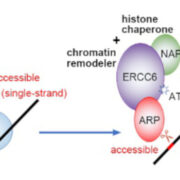HDT family histone deacetylases are nucleoplasmins
Bobde, Kumar, and Vasudevan explore the properties of a family of predicted histone deactetlyases, finding them to function as nucleoplasmins. https://doi.org/10.1093/plcell/koac275
Ruchir C. Bobde, Institute of Life Sciences, Bhubaneswar, Odisha – 751023, India; Ashish Kumar, Department of Molecular Biophysics & Biochemistry, Yale University, 260 Whitney Avenue, YSB 345, New Haven, CT, 06511, USA; Dileep Vasudevan, Institute of Life Sciences, Bhubaneswar, Odisha – 751023, India
Background: The eukaryotic genome gets condensed by a group of basic proteins called histones; DNA is wrapped around histones to form chromatin. Chromatin dynamics is crucial for regulating all DNA-templated processes. Histone acetylation and histone deacetylation are histone modifications that control chromatin dynamics and gene expression. A plant-specific family of histone deacetylases called HDTs has been reported. Arabidopsis thaliana possesses four HDT paralogs, viz. HDT1, HDT2, HDT3, and HDT4. Although the HDTs are classified as histone deacetylases, they share no sequence similarity to other known histone deacetylases, and there has been no direct evidence for HDTs performing deacetylation.
Question: The secondary structural analysis of HTDs showed a domain organization similar to the histone chaperone family of nucleoplasmins. We asked whether HDTs are indeed nucleoplasmins and, if so, what kind of histone interaction features they possess.
Findings: Crystal structures of HDT N-terminal domains revealed a nucleoplasmin fold with the classical pentameric organization. The pentameric nature of the proteins in solution was also confirmed. The nucleoplasmin core domain showed resistance to high temperature and salt and urea concentrations, similar to known nucleoplasmins. The core domain of HDTs could not interact with histone oligomers. However, upon including the acidic tract A2 C-terminal to the nucleoplasmin core domain, HDT2 pentamers interacted with H2A/H2B dimers and H3/H4 tetramers in a 1:1 stoichiometry. Although the putative histone deacetylation catalytic residues come in close proximity within the core of the pentamer, the recombinant HDTs showed no deacetylation activity.
Next steps: Through this work, we understand the nucleoplasmin function of HDTs. However, this study could not answer the question of whether the HDTs act as deacetylases. Additional co-factors could be needed for their deacetylation function. Understanding the exact mechanism of action of these multifunctional proteins will help us understand chromatin dynamics in plants.
Reference:
Ruchir C. Bobde , Ashish Kumar, Dileep Vasudevan (2022) Plant-specific HDT family histone deacetylases are nucleoplasmins. Plant Cell. https://doi.org/10.1093/plcell/koac275







